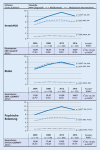[Diagnostics and therapy in children and adolescents with chronic pain : Trends in interventions potentially dangerous to health]
- PMID: 33185762
- PMCID: PMC7997831
- DOI: 10.1007/s00482-020-00506-5
[Diagnostics and therapy in children and adolescents with chronic pain : Trends in interventions potentially dangerous to health]
Abstract
Background and objectives: Current research on the treatment of chronic pain in children suggests an increasing trend internationally in the quantity as well as invasiveness of diagnostic and therapeutic interventions. The objective of this research was to examine the interventions received by patients before starting specialized inpatient pain treatment.
Materials and methods: A retrospective survey was conducted analyzing patient files from a tertiary children's pain center from 2004, 2008, 2012 and 2016 (N = 585). In addition to diagnostic and therapeutic interventions, pain and patients' characteristics were collected. The identified measures were subsequently evaluated by an interdisciplinary expert panel regarding their invasiveness, potential risk and degree of mental burden.
Results: An increase in diagnostic measures and medication was found up to 2012. Thereafter, a decreasing trend was identified (χ2(3) = 11.708; p = 0.008). Invasiveness (χ2(3) = 13.342; p = 0.004), risk (χ2(3) = 13.135; p = 0.004) and mental burden (χ2(3) = 14.403; p = 0.002) showed the same pattern of change. Patients with abdominal and limb pain are particularly at risk for highly invasive and high risk diagnostics.
Conclusions: Evidence for an increase in diagnostic and therapeutic measures in chronic pain was found up to 2012. Patients presenting with certain complaints receive comparably more invasive, risky and burdensome measures.
Zusammenfassung: HINTERGRUND UND ZIEL DER ARBEIT: Bei der Behandlung chronischer funktioneller Schmerzen im Kindes- und Jugendalter nimmt international sowohl die Anzahl an diagnostischen und therapeutischen Maßnahmen als auch ihre Invasivität zu. Studienziel ist die Erforschung der vor Beginn einer spezialisierten stationären Schmerztherapie durchgeführten, die pädiatrischen Patienten potenziell gefährdenden Maßnahmen in Deutschland.
Material und methoden: In einem retrospektiven Studiendesign wurden Patientenakten eines tertiären Kinderschmerzzentrums der Jahre 2004, 2008, 2012 und 2016 ausgewertet (N = 585). Neben diagnostischen und therapeutischen Maßnahmen wurden primäre Schmerzparameter und Patientencharakteristika erfasst. In einer interdisziplinären Expertenumfrage (N = 13) wurden die Invasivität, das Risiko und die psychische Belastung von Maßnahmen bewertet.
Ergebnisse: Diagnostische und medikamentöse Maßnahmen nehmen bis 2012 zu. Ab 2012 lässt sich ein abnehmender Trend erkennen (χ2(3) = 11,708; p = 0,008). Die Invasivität (χ2(3) = 13,342; p = 0,004), das Risiko (χ2(3) = 13,135; p = 0,004) und die psychische Belastung (χ2(3) = 14,403; p = 0,002) durchgeführter Maßnahmen zeigen ein gleiches Veränderungsmuster. In der Gesamtstichprobe sind Patienten mit Bauch- oder Gliederschmerzen besonders gefährdet für hoch invasive und sehr risikoreiche Diagnostik.
Diskussion: Eine Zunahme diagnostischer und therapeutischer Maßnahmen bei funktionellen Schmerzstörungen lässt sich nur bis 2012 beobachten. Bei bestimmten Patientengruppen kommen invasive, risikoreiche und die Psyche stärker belastende Maßnahmen häufiger zur Anwendung.
Keywords: Bio-psycho-social; Evidance based; Functional disorder; Iatrogenic chronification; Risk.
Similar articles
-
A meta-ethnography of how children and young people with chronic non-cancer pain and their families experience and understand their condition, pain services, and treatments.Cochrane Database Syst Rev. 2023 Oct 5;10(10):CD014873. doi: 10.1002/14651858.CD014873.pub2. Cochrane Database Syst Rev. 2023. PMID: 37795766 Free PMC article. Review.
-
Characteristics of highly impaired children with severe chronic pain: a 5-year retrospective study on 2249 pediatric pain patients.BMC Pediatr. 2012 May 16;12:54. doi: 10.1186/1471-2431-12-54. BMC Pediatr. 2012. PMID: 22591492 Free PMC article.
-
Interdisciplinary Pain Management Improves Pain and Function in Pediatric Patients with Chronic Pain Associated with Joint Hypermobility Syndrome.PM R. 2019 Feb;11(2):150-157. doi: 10.1016/j.pmrj.2018.06.018. Epub 2019 Feb 13. PM R. 2019. PMID: 30010052
-
Subanesthetic ketamine infusions for the treatment of children and adolescents with chronic pain: a longitudinal study.BMC Pediatr. 2015 Dec 1;15:198. doi: 10.1186/s12887-015-0515-4. BMC Pediatr. 2015. PMID: 26620833 Free PMC article.
-
Chronic non-cancer pain in children: we have a problem, but also solutions.Minerva Anestesiol. 2018 Sep;84(9):1081-1092. doi: 10.23736/S0375-9393.18.12367-4. Epub 2018 May 9. Minerva Anestesiol. 2018. PMID: 29745621 Review.
Cited by
-
[Chronic pain in children and adolescents].Monatsschr Kinderheilkd. 2023;171(2):163-166. doi: 10.1007/s00112-022-01694-3. Epub 2023 Jan 17. Monatsschr Kinderheilkd. 2023. PMID: 36684063 Free PMC article. German.
-
[Chronic pain in children and adolescents : The silent epidemic].Schmerz. 2021 Apr;35(2):80-82. doi: 10.1007/s00482-021-00542-9. Epub 2021 Mar 26. Schmerz. 2021. PMID: 33770248 German. No abstract available.
-
[Chronic pain in pediatric primary care : What do adolescents and parents expect and how do they perceive treatment?].Schmerz. 2022 Apr;36(2):89-98. doi: 10.1007/s00482-021-00564-3. Epub 2021 Jun 25. Schmerz. 2022. PMID: 34170398 German.
References
-
- Hyams JS, Di Lorenzo C, Saps M, Shulman RJ, Staiano A, van Tilburg M. Childhood functional gastrointestinal disorders: child/adolescent. Gastroenterology. 2016;150:1456–1468.e2. doi: 10.1053/j.gastro.2016.02.015. - DOI
MeSH terms
LinkOut - more resources
Full Text Sources
Medical



